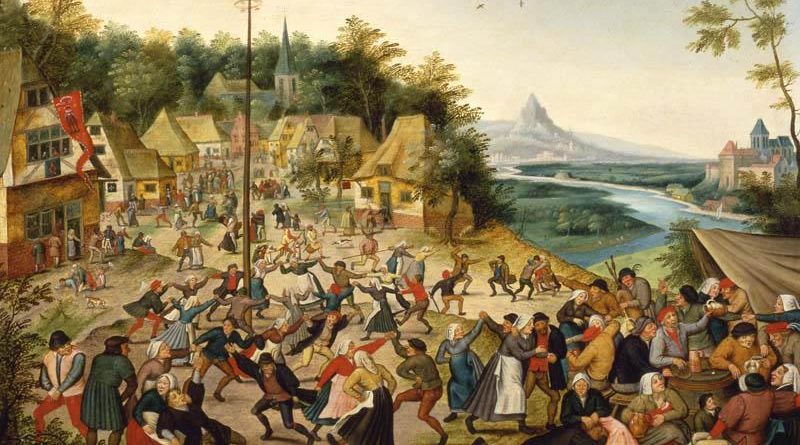Incorporating Mundane Life into Your Fantasy/Middle Ages Game: Religious Festivals, Tanning, Shearing, & Shoeing
Let’s look at even more mundane aspects of life in the Middle Ages for you to put into your game!
Local Religious Festivals
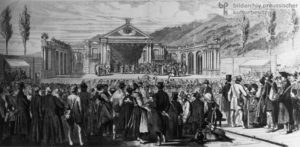 Take a look at the Roman Catholic calendar, and you’ll see that every single day is a feast day to some random saint, many of whom are ones you’ve never heard of. Now, this doesn’t mean there were parties every day, but instead a town or lord would have certain saints they chose to honor. On those days, based on the saint honored, they may dress up as the saint, or do something to honor the things the saint was the patron of. In a D&D setting, perhaps they hold a large festival on the day the first harvest begins, leading to anticipation as no one knows exactly when it will be. Perhaps the village worships the god of storms, and so holds a festival on the day of the first rainstorm of the year.
Take a look at the Roman Catholic calendar, and you’ll see that every single day is a feast day to some random saint, many of whom are ones you’ve never heard of. Now, this doesn’t mean there were parties every day, but instead a town or lord would have certain saints they chose to honor. On those days, based on the saint honored, they may dress up as the saint, or do something to honor the things the saint was the patron of. In a D&D setting, perhaps they hold a large festival on the day the first harvest begins, leading to anticipation as no one knows exactly when it will be. Perhaps the village worships the god of storms, and so holds a festival on the day of the first rainstorm of the year.
If you look at a lot of the descriptions of various festivals in the middle ages, they simply said, “Bonfires were lit,” meaning it was an excuse for everyone to build the biggest fire they could without getting in trouble. Lots of revelry and drinking would take place, as well as all kinds of debauchery, which might lead religious leaders to cancel the following years’ celebration.
Tanning
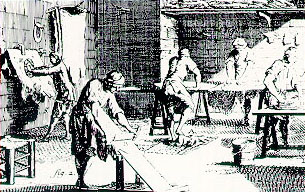
This section is gonna get a little gruesome.
Animal hide was provided to a tanner from the fellmonger (who was a specialist in removing animal skin from meat for tanning purposes), often with the hooves and horns still attached. Tanners would then begin their bloody work, cleaning and cutting the skin and treating it, which would mean laying it out across large beds and treating it with things like salt and other materials. Some skin would be turned into leather, some into parchment, and some into soft vellum. Horns would be then sold to horners for use in various projects, while they would boil the hooves to make glue. As you can probably tell, this was a REALLY smelly operation. As your players pass through town, make sure to bring attention to how badly this makes the whole city block reek with boiling and tanning animal parts. In a fantasy setting, the tanning skins would be fantastical creatures such as hippogryphs, wyverns and maybe even trolls?
In addition, unless a character is particularly skilled in removing animal skins, they’re unlikely to be able to sell that owlbear pelt directly to the tanner (they wouldn’t take such poor quality material), and would instead need to sell the whole body to a butcher or fellmonger.
Shearing
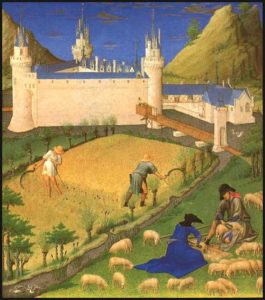 My aunt and uncle owned a sheepfarm when I was growing up, and we would often go visit them during shearing season, watching as they rounded up the fluffy animals, and pinned them in place to shear them. A skilled shearer can leave the sheep feeling nice and light without a single nick on them. My aunt regularly won blue ribbons at the local fair for her wool
My aunt and uncle owned a sheepfarm when I was growing up, and we would often go visit them during shearing season, watching as they rounded up the fluffy animals, and pinned them in place to shear them. A skilled shearer can leave the sheep feeling nice and light without a single nick on them. My aunt regularly won blue ribbons at the local fair for her wool
In the middle ages it was no different. After the herd’s wool has grown long enough, they are rounded up for shearing. Shearers would wear special clothing with extra leather and padding to protect from the sheep’s hooves as they kick, and to help hold the lamb in place. In the modern day, there will be competitions for who can most quickly shear, and you’d have to imagine the same would be done in the middle ages as well, even informally.
As the players pass by a farmhouse on their journey, perhaps they see a few shepherds gathered in a pen, racing one another to see who can shear the most sheep in a day, as large carts piled high with wool stack higher and higher, ready to be taken to market.
Shoeing
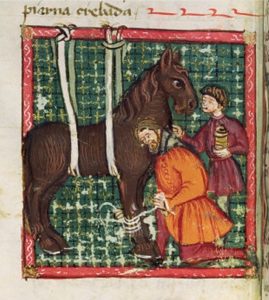 I love watching horse shoeing. At the bottom of this entry, I’ll include a great video showing shoers at work. It’s a lot of work cleaning up horses feet. They are essentially walking balanced on a single large toe, so their hooves are long and thick toe nails. There is a section of white calcium in the sole that gets cleaned up, the thick nail trimmed, and nails driven in with a horseshoe. It’s all painless to the horse, as there’s no nerves in there, and can be relieving if there’s been some buildup or if a twig has gotten stuck in their foot. Shoeing helps protect their feet from damage, especially if they’re walking the cobbled streets of the city.
I love watching horse shoeing. At the bottom of this entry, I’ll include a great video showing shoers at work. It’s a lot of work cleaning up horses feet. They are essentially walking balanced on a single large toe, so their hooves are long and thick toe nails. There is a section of white calcium in the sole that gets cleaned up, the thick nail trimmed, and nails driven in with a horseshoe. It’s all painless to the horse, as there’s no nerves in there, and can be relieving if there’s been some buildup or if a twig has gotten stuck in their foot. Shoeing helps protect their feet from damage, especially if they’re walking the cobbled streets of the city.
This also isn’t something just anyone can do. Your players should have to take their horses to a farrier (someone who takes care of horse shoes) to have them apply new shoes. They can see the horses held in place with leather straps as they set about their work.
Also note: Most peasants didn’t own horses. They were almost exclusively for the rich and nobility, so if you see a peasant walking around with an animal, it’s gonna generally be a donkey, ox, or cow.
I’ll definitely revisit this whole series soon, as I definitely want to talk to you about the people who had to wade in buckets of human urine every day in order to keep clothes soft. Seriously, it was a thing.
Support Dice Monkey with a single payment on Ko-Fi, or become a Dice Monkey Patron. Thank you for your support!

